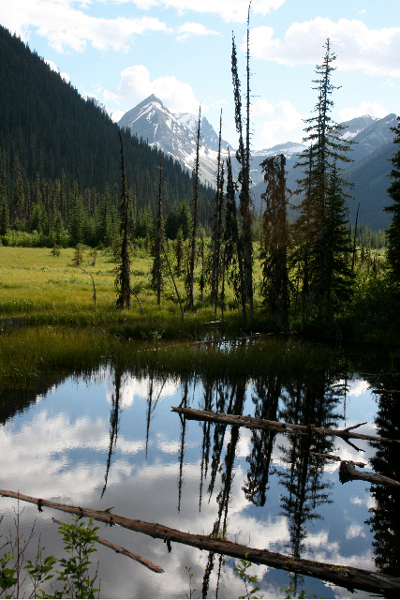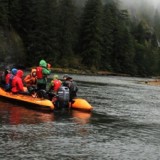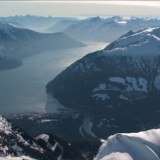The
Town of Golden may seem to be a backwater place in the middle of
nowhere, especially in comparison to the sprawling metropolis of the
lower mainland and other booming places in the province. It might
appear that nothing of importance ever happens here. But when it
comes to the environment, and in particular to the rampant push for
independent power producer (IPP) projects, we’ve had to face our
battles just as much as anywhere else.
I’d
like to share with you a little information about what’s
been happening in the Upper Columbia Valley in regards to the IPP
issue. It is not a story that is well known, and this account will
give you insight into the potential long-term environmental
consequences for the region. This story also signifies what is
happening in small towns all over British Columbia.
It
begins with a pristine creek in an out-of-the-way river drainage
called Ventego Creek. Even in our area, where backcountry pursuits
are a way of life, few have heard of this place, and fewer still
would ever dream of traveling into this treacherous valley. Yet,
with helicopters and dynamite, and dreams of entering the “green”
economy, a Nelson-based company called Selkirk Power has imposed
itself on this remote wilderness. Thus, one aspect of this story is
about the disastrous consequences of this project should it go
forward. The company has already embarked on a ruinous fish
translocation project within a unique sub-alpine wetland area. In
the future, half of the drainage will be blasted open to accommodate
new infrastructure with profound environmental consequences. This is
not a suitable location for a run-of-river project.
This
story is also about the wider context of IPP development in the
region, and the province at large. It appears at times, that entire
regions are put up for sale on the auction block, especially when the
region is sparsely populated. In our locale, a geographical area
from Kinbasket Reservoir to Revelstoke Reservoir is threatened by
multiple IPP projects. Should the first project be allowed to
proceed, several other projects are highly likely to follow quickly
on its heels. That is why it is so important to halt Selkirk Power
and its project at Ventego Creek before it starts. We cannot afford
to leave just one project behind.
A
Golden Battle: Independent Power Producer Projects in the Upper
Columbia
To
tell the story in its proper context, a small history of IPP issues
in the Upper Columbia area is required. To date, the residents of the
Golden – a surprisingly active and educated bunch – have managed to
ward off several proposed projects that have threatened to proceed
without a local approval process. Two projects were particularly
contentious between the years 2006-2008, these were smaller
run-of-river projects proposed near the Town of Golden. Next, there
was the company, AXOR Group with a much larger 99MW proposal on
Glacier/Howser. This drew busloads of residents out of their homes to
show opposition to the project. Over 1100 people went to the public
meeting in Kaslo, more than the entire population of that small
Kootenay community!
After
that, there was Atla Energy, a company with three proposals on the
wild and untamed Upper Wood River. This area is so remote that
simply traveling there is an all day affair that involves several
hours of driving, arranging a special ferry, and significant
bushwhacking to access the river. To counter this illogical proposal,
the Golden chapter of Wildsight, assisted by the Council of
Canadians, created a documentary video and distributed it widely. You
can check out the video at:
http://www.wildsight.ca/wood-river-atla-energy-corporation.
Our little ol’ Town of Golden has a long history of success where
these projects are concerned.
Each
project, in one way or another, was stopped dead its tracks. It is
impossible to pin point precisely why or how this was accomplished.
Each case is different and each project lies dormant to different
degrees, for now at least anyways. But this doesn’t mean the
battle is over, far from it in fact. The next proposal has emerged.
Biggest
Regional IPP Threat: Selkirk Power at Ventego Creek
 In
In
November 2010, it was announced that AXOR, a Canadian leader in the
development of large-scale engineering and construction projects, no
longer holds an Energy Purchase Agreement (EPA) with BC Hydro for the
controversial Glacier/Howser IPP project. This should significantly
slow this project moving forward. This also makes the proposal on
Ventego Creek the next biggest environmental threat in terms of IPP’s
in this region. The proponent, Selkirk Power, has gained its EPA and
is hopeful to begin construction next spring on a single project that
involves developing two adjacent river drainages for a combined 44 MW
project. One drainage, Ventego Creek, is of particular importance
given its high wilderness, ecological and biodiversity values.
Ventego
Creek meanders through a long pristine watershed that extends for
about 18km and is located in the northern Selkirk Mountain range.
The glaciers that feed Ventego sit atop tall mountain peaks, which
form the border with Glacier National Park. At the back of the
drainage there sits a high alpine lake, which plunges into a
spectacular and dramatic waterfall to form the start of the creek.
Ventego Creek is fed by 19 additional tributaries as you go down the
valley, some of which contain spectacular waterfalls of their own.
The valley is steep and the water flows at deathly rates of speed in
some areas. The high velocity of the water flow makes it desirable
for hydropower production.
The
Ventego Creek proposal is of special concern for a variety of
reasons. First, the Ventego drainage has never seen the human hand of
development. There are no roads or even any recreationally used
trails; the foliage is incredibly thick. There are also numerous
avalanche paths in this valley, which makes it prime bear habitat.
Additionally, there has never been a credible scientific wildlife or
plant survey conducted in the Ventego Creek drainage, so we don’t
know the significance of the biodiversity that would be lost were
this project to be approved and move forward.
In
July 2010, a small group of us set out to hike the Ventego Creek
drainage in order to document the area with photographs and raise
awareness about these run-of-river projects. Because of the harsh
conditions, the trip nearly became a deadly survival scenario, with
myself on the receiving end! But that is another story altogether.
Along the way, we conducted an informal wildlife survey of sorts,
simply documenting what we found. We encountered bear daybeds, a
bear rub tree and extensive bear scat. We traveled along multiple
game trails, and were even forced to sleep on one due to the
extensive steepness of the surrounding terrain. We also saw
extensive moose and other ungulate scat, Columbian spotted frogs,
osprey, waterfowl, varied thrush, marsh wren, and many other species
of bird that we were unable to identify. There have also been
unconfirmed reports of Black Wolves spotted in the wintertime, and
even the endangered Mountain Caribou. Clearly, the valley belongs to
someone.
Second,
in the middle of the river drainage there lays a 5.6 km stretch of
unique sub-alpine wetland that has remained unchanged since the last
ice age. The proponent Selkirk Power, has begun a controversial fish
translocation project in the Ventego Wetlands. In order to
compensate for the loss of habitat on neighbouring Cupola Creek, the
company began introducing blue-listed westslope cutthroat trout into
this unique amphibian-filled ecosystem, where previous to the
introduction predatory fish did not exist. This alters the natural
equilibrium that has evolved here. The fish translocation project was
to take place involving a multi-step process, gradually introducing
more and more fish, but significant opposition to the project
emerged. The environmental group Wildsight and a First Nations group
called the Ktunaxa have both taken a stand against it. The fish
translocation has since been halted, an event that was big news for
the environmental community in these parts. The story is available
to read here:
http://www.bclocalnews.com/kootenay_rockies/thegoldenstar/news/108436954.html.
Somehow, the Provincial Ministry of Environment and the Federal
Department of Fisheries and Oceans approved the idea of a fish
translocation into a pristine wetland. This is a clear example of
how these projects can go wrong, despite a rigorous application
process.
Third,
the project offers no public benefit, while the local community
inherits a laundry list of associated problems. The plans for this
project call for a new 8.8 km road extending halfway into Ventego to
the edge of the wetlands, increasing the vulnerability of this
already exploited ecosystem. Blasting for the construction of the
road and the intake pipe will be extensive given the rugged terrain,
further disturbing sensitive animal habitat. Despite assurances from
the proponent, recreational vehicles may begin accessing the drainage
through new road infrastructure, which also increases the potential
to introduce invasive plant species that travel on their tires. The
plans also call for 40 km of associated transmission lines to
interconnect with the nearest Town of Golden. Aside from compromised
aesthetic values, in an area that is surround by four National Parks,
other proponents will piggy-back on the infrastructure resulting in
more projects down the road. Thus, while private power producers
gain profits through the sale of electricity to BC Hydro on public
land, residents of the local area are left to deal with the mess.
A
Story with a Twist: Transmission Lines and IPPs
 Another
Another
important factor to consider about the project is that it is the
first of a series of proposals within a geographic locale that is
slated for IPP development. The area where Ventego Creek is located
is known to BC Hydro as the Beaver River “cluster.” Selkirk
Powers holds proposals on two creeks within the cluster, further
north there another five proposals held by a large Albertan energy
company named Trans-Alta. Already these creeks are being monitored
with flow measuring equipment and they are waiting on BC Hydro’s
next Clean Power Call for purchase contracts. One of the five
proposals within the Beaver River cluster also lies within a pristine
river drainage, Palmer Creek. Should the first project be approved,
it would greatly facilitate the remaining projects within the
cluster.
The
fact that the IPPs located within the Beaver River cluster will be
developed in tandem with each other was discovered earlier this year
when BC Transmission Corporation (now BC Hydro) sought approval from
the now dismantled BC Utilities Corporation to build a transmission
line. This summer, BC Hydro approved the construction of a 112 km
Columbia Valley Transmission line (CVT line) from Invermere to
Golden. Contained within the application for the transmission line,
there was an economic study conducted for the purpose of estimating
the profits that would be gained through interconnection fees of up
to 24 run-of-river projects in two “cluster”
areas known as Beaver River and Goldstream River. At the present
time, the cluster on Goldstream River is not moving forward, the
Beaver River cluster however, begins with Selkirk Power.
Widespread
opposition exists both to the transmission line and the IPP project
on Ventego Creek. Wildsight vehemently opposed the construction of
the CVT line through a written hearing process. The group made the
argument that BCTC failed to inform the communities of Golden and
Invermere of one of the primary functions of the CVT line – the fact
that it would be used to transport power from the two cluster areas
south into the valley. According to the application for the
transmission line, the development would enable cross-border energy
trade. Furthermore, the Council of Canadians (Golden) has a petition
with over 500 signatures opposing the project on Ventego and Cupola
Creeks. With the provincial government in a state of upheaval, and
with minister portfolios changing at alarming frequency, it is
important that Ventego Creek not be left by the wayside.
Take
Action Now!
As
Selkirk Power is hopeful to begin construction on the project at
Ventego Creek next spring, it is important that we as
environmentally-minded communities come together to take action now.
This IPP project is particularly important to stop because it
threatens a pristine river drainage, an increasingly rare piece of
real-estate in these times of fast development.
However,
there are larger reasons for stopping this project as well. We
cannot sit idly by as the government apportions large tracts of
remote wilderness for sale on the energy market. The Upper Columbia
region is not the only area in the province where transmission lines
are being used to activate large clusters of IPPs within a confined
geographic locale. These projects need to be proven to be in the
public interest, and when pristine areas are threatened, it is very
difficult to make the case that they are.
To
learn more about Selkirk Power’s
projects, visit:
http://www.wildsight.ca/ventegocupola-creeks-selkirk-power
James Knoop is a freelance writer and President of the Council of Canadians Golden Chapter



 In
In Another
Another


